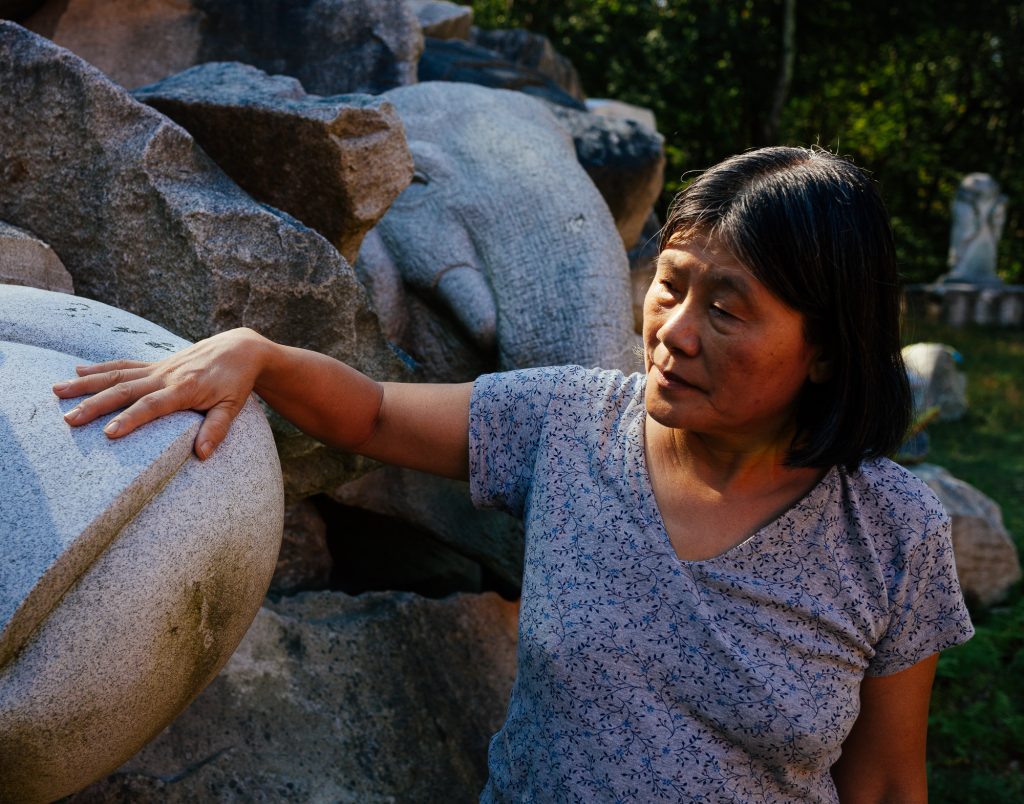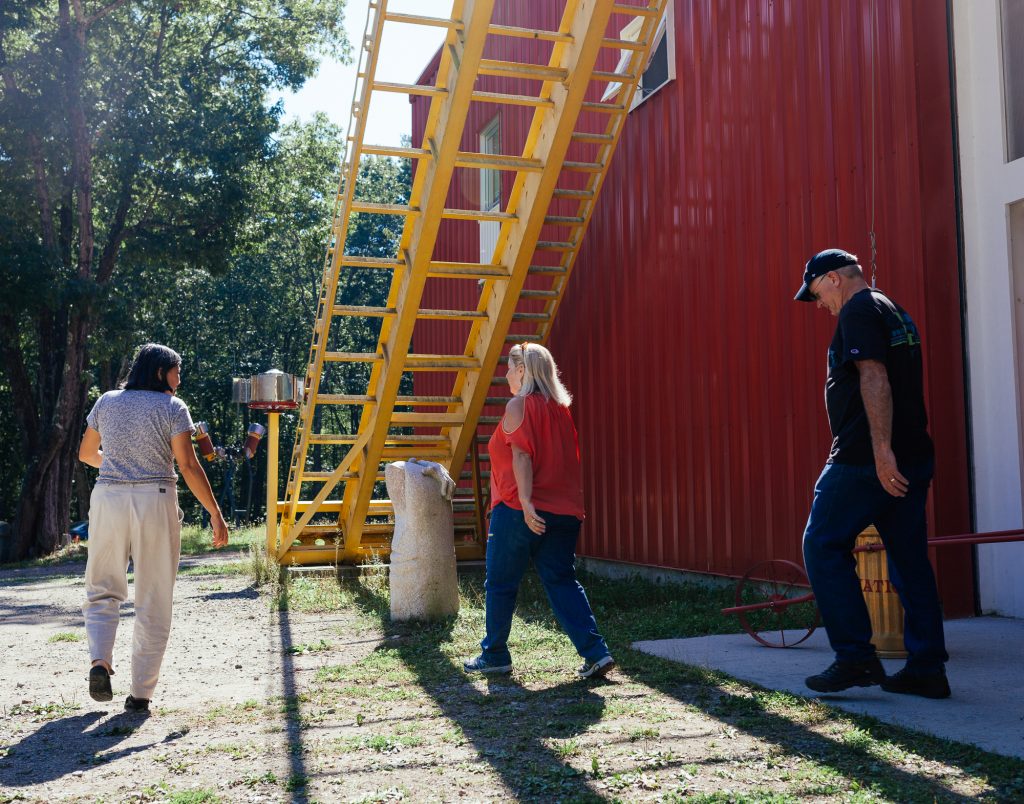
Nine Generations
Yin can trace back her family’s history in Taiwan nine generations. She grew up the youngest of five children, and even though her family was not well off, she was the most spoiled. Her father read three newspapers a day and worked as a chemist for a wine company, so he was rarely home.
“If I inherited anything from father, it is that I am pretty daring.”
Yin’s father would often recite a haiku, which she translates:
“I love life. I love food. So I’m going to eat blowfish – that would be the ultimate taste of my life.” (audio below)
Yin’s parents lived through Japan’s occupation of Taiwan. Consequently, they both spoke perfect Japanese and used it to communicate with each other. Yin, who didn’t learn the language, wasn’t able to understand. When Yin was a child, Taiwan was under Chinese control. Her school forced her to learn and speak Mandarin (Chinese). Today, Yin considers Chinese to be her intellectual language, and whereas Taiwanese is her emotional language. (audio below)

American Apples
Yin lived near a US military base that occupied the best beach in Tainan City. She knew little about America but quickly learned about the American dollar. It was incredible how much you could buy when you converted one dollar to Taiwan’s currency (NT). One item that she remembers being very expensive and sought-after growing up was the American apple. (audio below)
Yin studied English literature at a college in Taiwan. She met an American cultural anthropologist who was there researching, and they soon were married. After their marriage, he couldn’t find a full-time teaching job in Taiwan, so they moved to the United States.
“I wish we had stayed in Taiwan.”

Suffocation
It was the day before Christmas 1982 when Yin arrived in Connecticut. Yin, age 24, and her husband moved in with his parents.
Yin had “feelings of suffocation” when she witnessed the first heavy snow of her life. She tried to convince herself that this cold fluffy white stuff is harmless and saw other’s having fun in it, but reflects, “I don’t think I ever got rid of that feeling of suffocating.” (audio below)
Yin’s father-in-law was a well-respected lawyer. He made sure everyone in their small, predominantly white, Connecticut town knew that Yin was his daughter-in-law. In retrospect, she sees how much she struggled to fit in. Her husband’s family – affluent and educated -contrasted with her humble upbringing. Yin always felt like they were above her, and this feeling became a source of constant stress. When her parents visited Connecticut, they found her in-laws to be arrogant, and over time, Yin started to see what they had seen too.
Artistic Expression
From an early age, Yin was passionate about art, and in high school, she would make seal carvings on tiny stones. Still, her parents never supported her artistic aspirations.
After getting settled in Connecticut, Yin started traveling to New York to study sculpturing at the National Academy of Design. She remembers her studies as being fulfilling and intensive. This experience made her believe that she could be an artist.

His Depression
Yin’s husband, a Ph.D. in cultural anthropology, was always in and out of the United States consulting for international development projects. Aside from being away all the time, he had ongoing battles with depression, something Yin tried to understand, but could not.
“I’m a very upbeat person. I had never known what depression means. I was dealing with his depression.”
They eventually moved to Ithaca, New York, so that her husband could earn a second Ph.D. at Cornell. Yin spent her days alone in the apartment, isolated and without friends.
“Enjoying life became very hard.”
Yin started a master’s degree in fine art at Cornell but she dropped out after a professor accused Yin of working too hard and exhausting the school’s resources. (audio below)

Nepal
Yin’s husband received an offer to work on an international development project with USAID (United States Agency for International Development) in Nepal. Yin encouraged him to take it. They spent five years in Tulsipur, where they had two children, and Yin spent a lot of time painting in the backyard. They had seven “servants,” who could take care of the children, giving Yin time to focus on her art. She was able to learn the ancient tradition of bronze casting from a Nepalese master. (audio below)
Disconnection
Yin and her family returned to the United States in 1988 and decided to settle in Massachusetts. Yin, curious about the academic side of art, started a master’s program at the University of Massachusetts.
Yin’s loneliness increased, as her husband’s depression deepened. “We drifted apart gradually”. Yin threw herself into her art to distract herself from her failing marriage. Her husband would usually leave on four-month contracts. At one point, due to a commitment associated with the Bosnian War (1992-95), he left for a full year and a half. When he returned, it was only for ten days.

Looking after her children, cooking, taking care of the house, and studying and creating art was a lot for Yin, especially after being used to having “servants” in Nepal. Yin felt like a single parent – she and her husband had stopped communicating.
“He would always tell me when we were driving to the airport, ‘Yes, I think we need to talk’ Then, two months later, I would pick him up [but we never talked]. If you really meant to talk, you would say this to me when I pick you up at the airport, not when you are leaving.” (audio below)
In 2005, after 23 years of marriage, they separated. Despite the failure of their relationship, Yin says her husband was always a gentleman.

Quarry Life
Yin created a sculpture of Aristotle and Plato but felt like bronze wasn’t the correct medium. She imagined it in stone and reached out to a professional stone carver to see if he could teach her. He took her to a quarry in Chelmsford, Massachusetts, helped her choose a rock, and began to teach her the art of stone carving. Yin spent six months completing her first piece at the quarry, carving in all types of weather – snow, freezing rain – it didn’t matter.
“I had children back home, so I would run home to cook, send the kids to school, and then run to the quarry.” (audio below)

The family who owned the quarry didn’t charge Yin for using their land, and they went on to develop a strong bond. Yin calls the owner her “quarry father.” He would often leave one page of the bible on her stone and a piece of chocolate. She remembers him remarking to her, “You know I have never seen any man work this hard in my life.” Over the course of almost a decade, Yin carved at least 40 pieces in the Chelmsford quarry.
Container Man
In 1994, for the first time, Yin tried to create a sculpture that involved sound. After creating it, she wasn’t sure what she was going to do with it and stored it away. Then six years later, in 2000 at an art symposium, she met a Hungarian artist named Viktor. She was impressed by his ability to create instruments and invited him to collaborate with her. In 2002 she received a small grant and they were able to start their collaboration. While working on the project, their connection grew.
“I fell in love with him. He sees what I don’t see.”
In 2005 Container Man, which consists of 14 mechanical kinetic musical instruments and equipped with a sound system and multimedia projection capabilities, went to Europe. Yin felt refreshed being around Viktor’s creative mind.

Contemporary Arts International
Eventually, Yin’s “quarry father” told her, “You have got to find land for all these sculptures!” He helped Yin find a quarry in Acton, which she bought in 2003 for “a very good price.” The person who sold the land believed in Yin’s dream of using it to create art.
While working as a Chinese court interpreter, Yin spent weekends with Viktor at the quarry cleaning it out.
“It was a very dirty jungle – millions of bullet shells, broken glass, 27 cars, household goods, cabinets, and chairs!”
When it was ready, they started constructing Contemporary Arts International – a large studio and residency house- from the ground up.
“We built up this place with our bare hands.”
This mission of Yin and Viktor’s nonprofit is to promote the creation, understanding, and appreciation of contemporary art in the global context. On their land, visitors can find more than 100 stone and kinetic metal sculptures.
A Place to Stand
In hindsight, Yin feels lucky to have been so protected by her former husband and her father-in-law when she arrived in that small white Connecticut town.

Yin explains how she is enjoying the efforts of people who immigrated to America before her. She appreciates that those people established the rules and regulations that make the country the way it is today. It is for this reason that in American, Yin says she has willingly been “secondary.” Still, today after decades in the country, she feels like she has earned the right to raise her voice.
“I now am contributing just as much as you to this country. Therefore, I have my place to stand, and you cannot move me.” (audio below)
#FINDINGAMERICAN
To receive updates on the book release and exhibition of “Finding American: Stories of Immigration from all 50 States” please subscribe here. This project is a labor of love and passion. If you would like to support its continuation, it would be greatly appreciated!
© Photos and text by Colin Boyd Shafer | Edited by Kate Kamo McHugh. Quotes edited for clarity and brevity.




























